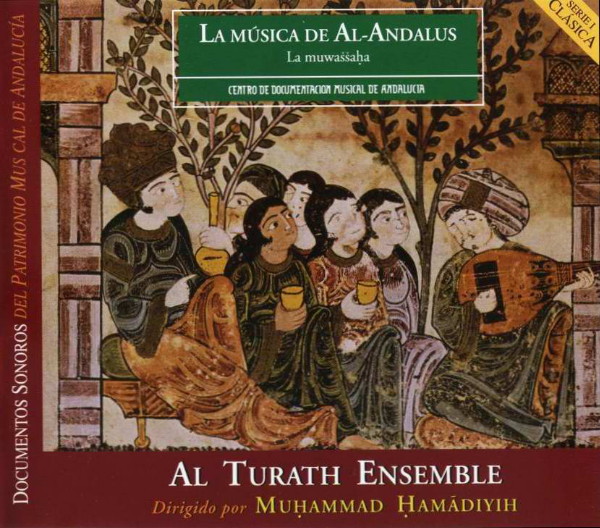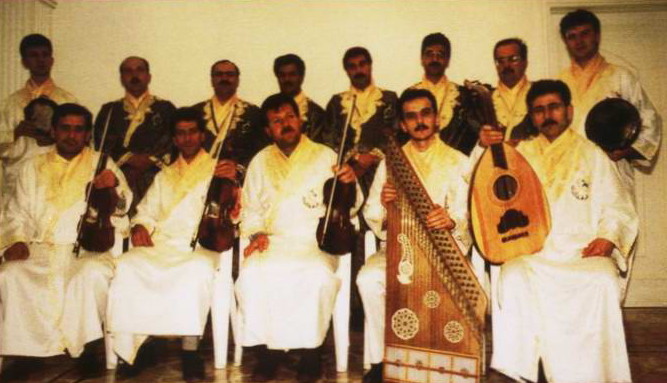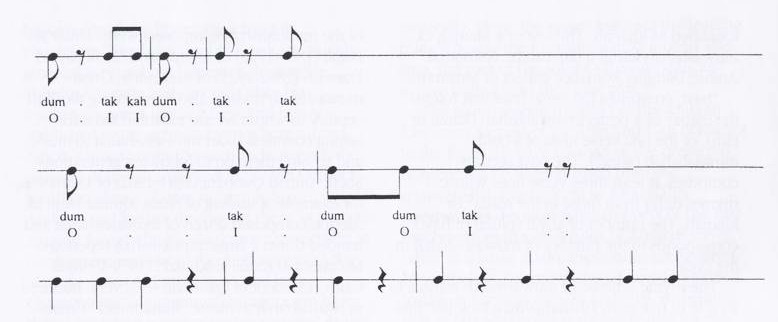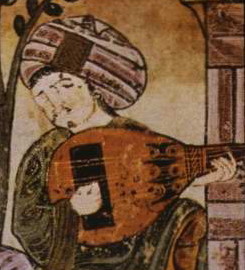
medieval.org
Almaviva 0123
abril de 1996
Alepo
موسيقى أندلسية • La música de al-Andalus
موشـّحات • La muwaššaḥa
التراث • al-turāth
waṣlah de maqām ḥijāz

medieval.org
Almaviva 0123
abril de 1996
Alepo
موسيقى أندلسية • La
música de al-Andalus
موشـّحات • La
muwaššaḥa
التراث • al-turāth
waṣlah de maqām ḥijāz
The andalusi
muwashshaḥ
01 - samāºi [7:07]
02 - muwashshaḥa. yā ghuṣayna-l-bāni [3:18]
03 - muwashshaḥa. mā-htiyālī' [5:38]
04 - muwashshaḥa. hajarnī ḥabībī [1:40]
05 - muwashshaḥa. yā fātina-l-ghuzlān [4:33]
06 - muwashshaḥa. ºunqu-l-malīḥ [3:45]
07 - dūlāb [2:50]
08 - taqsīm [1:49]
09 - layālī. yā laylī yā ºaynī [5:25]
10 - qaṣīdah [8:26]
11 - qad. yā māyilah ºalā-l-ghuṣūn ºaynī [6:09]
12 - mawwāl [4:40]
13 - qad. fūq an-nakhil [4:49]
14 - qad. al-bulbul nāghā ºaghuṣni-l-fill [4:50]
15 - qad. qadduka-l-mayyās yā ºumrī [6:58]
16 - qad. bīnī w-bīnak ḥārū-l-ºawāzil [2:55]
AL-TURATH ENSEMBLE
dirección: Muhammad Hamadiyih / Muḥammad Ḥamādiyih
solistas y coristas: Mahmūd Fāris, Rabīº ash-Shahir, Ahmad
Kabbari, ºAli Muhsin
coristas: Mahmud Hamadiyih, Muhammad Hamadiyih
kamān (violín): ºAbd al-Basit Bakkar, Rafwan
ºAbd al-Qadir, Khalid Budaqah
ºūd (laúd): ºAbd ar-Rahim ºAjin
qānūn: Yusif Salim
riqq (tambor): Jamal Shamiyih
darabukkah (tambor): ºAbd al-Qadir Shamiyih

THE ANDALUSI WAṢLAH
OF ALEPPO, SYRIA
waṣlah
A waṣlah is the performance of up to eight muwashshaḥāt
(plural of muwashshaḥa) in succession together with an
instrumental introduction. Common to all sections of such a waṣlah
cycle is the principle maqām row, whereby the combination of
pieces can comprise the works of several poets and composers. The
muwashshaḥ composition played at the beginning of a cycle may have a
longer wazn than the muwashshaḥāt that follow. A total of 22
waṣlāt (plural of waṣlah) are known in Aleppo, each of them named
according to the maqām row to which it belongs (for exmple, waṣlah of
maqām rāst, waṣlah of maqām ḥijāz, waṣlah of maqām sīkāh).
maqām
The term maqām designates a modal framework in the music of the Arabs.
It denotes not just the intervallic distances between tones of
specifics order, but rather the mood created throught realization and
presentation of the modal framework based on such on order of
intervallic distances, which themselves make up what is called the
maqām row or the maqām mode. From a historical point of view, the term
maqām became a common property of Arabic-Islamic musical scholars in
the fourtenth century.
The maqām represents a unique improvisatory process in the art music of
the Arabs and in the art music of a large part of the world
encompassing the cultures of North Africa, West and Central Asia. The
structure of a maqām depends upon the extent upon to which the tonal
and temporal factors exhibit a fixed or free organization. The
tonal-spatial component is organized, molded and emphasized to such a
degree that it represents the essential and decisive factor in the
maqām, whereas the temporal-rhythmic aspect in this music is not
subject to a definite form of organization. In this very circumtance
lies the most essential feature of the maqām phenomenon, that is, a
free organization of the rhythmic-temporal and an obligatory and fixed
organization of the tonal spatial aspect. The maqām is thus not subject
to rules of organization where the temporal parameter is concerned,
that is, it has neither a regularly recurring and stablished bar scheme
nor an unchanging tactus. The rhythm characterizes the performer's
style and is dependent on his manner and technique of playing or
singing but is never characteristic of the maqām as such. The singular
feature of this form is one which is not built upon motifs, their
elaboration, variation and development, but throught a number of
melodic passages of different lengths that realize one or more
tone-levels in space and thus establish the various phases in the
development of the maqām. The maqām is based upon a systematic
realization of tone-levels which gradually move upwards from the lower
to the higher registers until the climax is reached, at which point the
form is completed. The realization of a truly convincing and original
maqām requires a creative faculty like that of a composer of genius.
Nevertheless, this phenomenon can only in part be considered as a
composed form because no maqām can be identical with any other: each
time it is recreated as a new composition. The compositional factor
shows itself on the predetermined tonal-spatial organization of the
fixed number of tone-levels without repetitions, while the
improvisational aspects freely unfolds in the rhythmic-temporal layout.
The interplay of composition and improvisation is one of the most
distinctive features of the maqām-phenomenon.
wazn
Genres with a fixed rhythmic-temporal organization have clear, compact,
regularly recurring measures which cause an organized, easily
recognizable segmentation of time. The muwashshaḥ belongs to this
genre. On the other hand, genres with a free rhythmic-temporal
organization have a rhythmic-temporal structure without regularly
recurring measures and motives and without displaying a fixed meter
(pulse). The taqsīm belongs to this genre. Nevertheless, the rhythmic
pattern in Arabian music is called wazn, literally "measure". Such
patterns are also known by the names uṣūl, mizān y ḍarb.
The Arabian wazn repertoire is comprised of approximately 100 cycles.
A few examples of Arabian awzān (plural of wazn) rhythmic patterns:

The term muwashshaḥ is applied to an autonomous vocal art music genre
of the Arabs that is textually based on the poetic form of the same
name. In his book dār aṭ-ṭirāz, the autor Ibn Sanāº al
Mulk (1155-1211) defines the muwashshaḥ as a poetry of a special meter
(syllabic groups) kalām manẓūm ºala wazn makhṣūṣ. The word
muwashshaḥ means precisely adorned with and is derived from the
expression wishāḥ, which denotes a woman's decorated scarf with
pearls and jewels. The poetic form of a muwashshaḥ incorporates a
certain number of verse lines grouped into two categories: maṭlaº
or madhhab and bayt.
maṭlaº, or madhhab, comprises at least two verse lines,
whose end rhymes may be similar (aa) or dissimilar (ab). A muwashshaḥ
is called kāmil or ṭām, that is, perfect or complete,
when it comprises a maṭlaº; otherwise it is labelled aqraº,
that is, bald. However, the first muwashshaḥ in a cycle is always
complete, while next muwashshaḥ can be bald. A ideal cycle comprises
five muwashshaḥāt, though it should be noted that the last muwashshaḥ
is identified as kharjah. The text of a kharjah, a muwashshaḥ
kāmil or ṭām, can be colloquial Arabic, bilingual Romance dialect or
Mozarabic.
bayt comprises the verse lines that follow the maṭlaº of a
perfect muwashshaḥ (kāmil or ṭām), or the first verse lines of a bald
muwashshaḥ (aqraº). The bayt section comprises at least three
verse lines whose rhymes differ from those in the maṭlaº or
kharjah. The number of abyāt (plural of bayt) corresponds to the number
of muwashshaḥāt in the cycle.
This poetic form is also known by the name zajal. Zajal poems,
though, may be composed in colloquial Arabic. Muwashshaḥ poets avail
themselves of classical Arabic.
A specific muwashshaḥ can be more precisely identified by naming the
first line of the poem, the principle maqām row, the accompanying
rhythmic pattern as well as the names of the poet and composer. For
most of the well known traditional muwashshaḥāt, however, data
pertaining to the person of the poet and composer is lacking. In place
of this information, one ususlly encounters the reference qadīm
("old").
Regarded as the most productive and original of the muwashshaḥ
composers were ºUmar al-Batsh (1885-1950) of Aleppo and Sheik
Sayyid Darwish (1892-1923) of Alejandría. Great muwashshaḥ
masters also lived during the 19th century to whom we are indebted
today for setting countless older muwashshaḥāt to music and passing
them on to following generations. Sheik Ahmad Qabbāni (1841-1902) of
Damascus, for example, a student of Sheik Aḥmad ºAqil of Aleppo,
composed dozen of muwashshaḥāt and handed down a large muwashshaḥ
repertoire. Muḥammad Kāmil al-Khulaci (1879-1938) of Cairo, a student
of Qabbāni, set several hundred muwashshaḥāt to music. Muḥammad
ºUtmān (1855-1900) of Cairo, student of the great qanun master
Qustāndi Mansi, created more than 150 muwashshaḥāt. Among-the important
muwashshaḥ researchers and collectors to be mentioned are in particular
the Lebanese Salim Hīlu, the late Sheikh ºAli Darwīsh and his son
Nadīm of Aleppo, as well as Ibraḥīm Shafiq of Cairo.
In the 9th century, Ziryāb, the great singer at the court of Harūn
ar-Rashīd, left Bagdad after a quarrel with his teacher, Isḥāq
al-Mawṣilī and emigrated to Islamic Spain, i.e., Al-Andalus. He founded
a music school in Cordoba where he carried on the musical tradition of
the early Arabian Classical School of Baghdad - not, however, without
liberating it from its classicism. Ziryab's school in Cordoba quickly
attained far-reaching influence. In Seville, Toledo, Valencia and
Granada also, his teachings were a guiding light and newly stablished
music schools everywhere turned Ziryab's innovations to practice.
However, the muwashshaḥ was invented in the 9th Century by Muqaddam
al-Qabrí in Islamic Spain, i.e., Al-Andalus, and further
developed there as a poetic musical form before it also came
appreciated in the esastem regions of the Arabian world, the Mashriq
states of Egypt, Syria and Iraq. Characteristic of the muwashshaḥ poem
is that althought it is composed in classical Arabic, it is not based
on any of the 16 classical meters of Arabian poetry. Otherwise also,
the muwashshaḥ poem does not exhibit any fixed sequence of stress and
arsis, but rather groups these to conform to a specific musical
rhythmic pattern (wazn). Thus, linguistic and musical rhythm in the
muwashshaḥ are inseparably linked to one another. The musical form ABA
is analogous to the poetic form AAbbbAA or ABABcccABAB. The term
muwashshaḥ, however, not only designates the poem, but also the musical
section in which the poem is sung. In each muwashshaḥ the tones and
tonal areas characteristic of the maqām are developed musically. Here,
the singer assumes the leading role. Whereas the instrumentalists
indeed also sing, the part of the soloist often appears an octave
higher than the choir part.
The muwashshaḥ tradition of the Arabian East - from Aleppo of the 18th
and 19th centuries to the Egyptian muwashshaḥ of the present - is,
however, to be distinguished from the muwashshaḥ poetic form of
Al-Andalus inasmuch as the muwashshaḥ poets of the East feel bound to
the strict rules of Arabian meter, while in Islamic Spain, these rules
are ignored. Nevertheless, the muwashshaḥ is still regarded today, in
Mashriq also, as andalusí, something that in fact also holds
completely true for the musical performance form.
In a muwashshaḥ ensemble, the instrumentalists often also make up the
choir. The part of the solo singer consists usually of only a few of
the lines presented. The instruments performing are the plucked short
necked lute (ºūd), the violin (kamanjah), the
plucked box zither (qanūn), the goblet drum (darabukkah)
and the tambourine (daff). In Aleppo, muwashshaḥāt were composed
on several maqām rows and presenting up to three awzān. Moreover, in
the bayt section of a muwashshaḥ, it was also possible to modulate to
neighboring maqāmāt.
